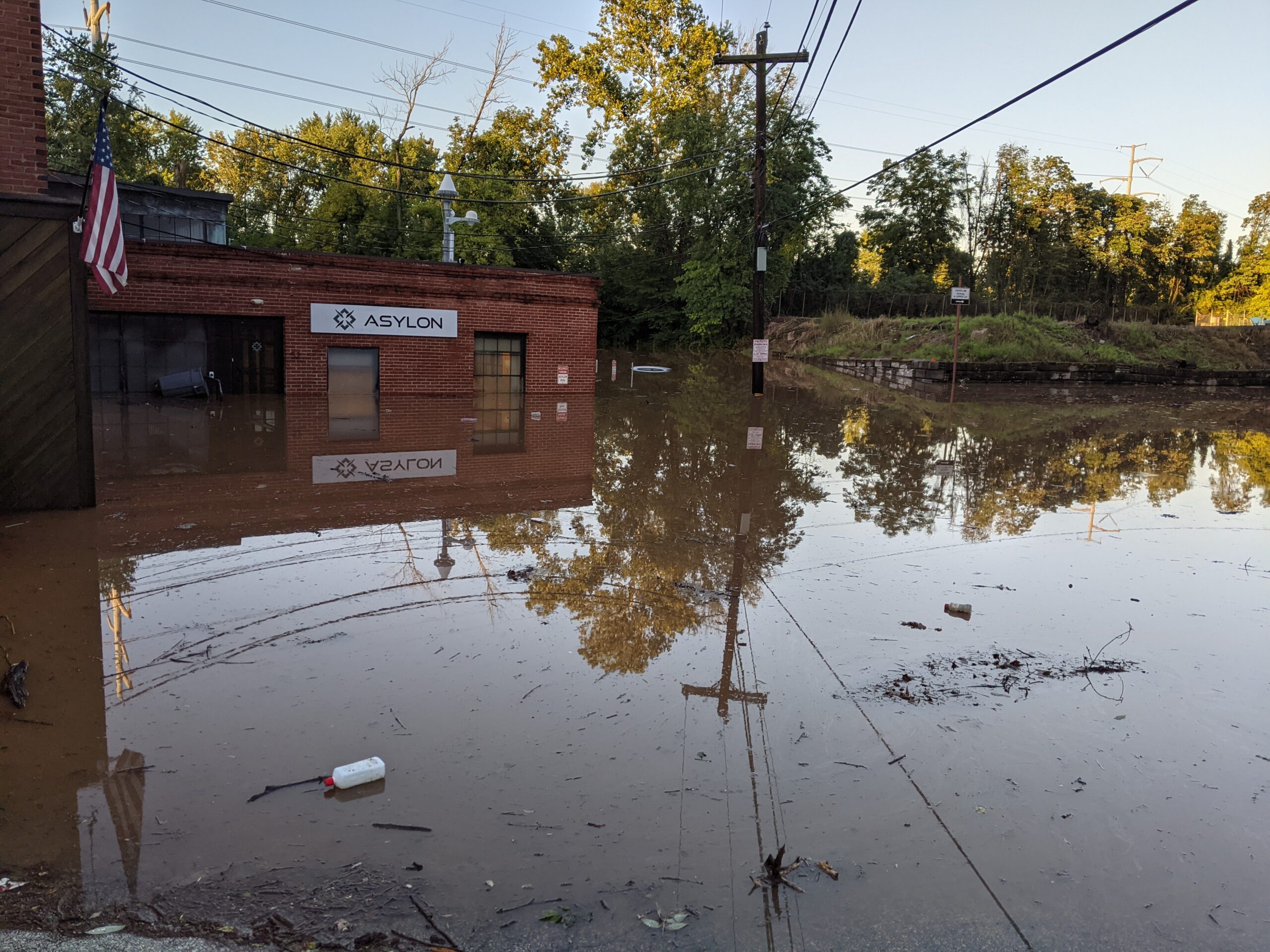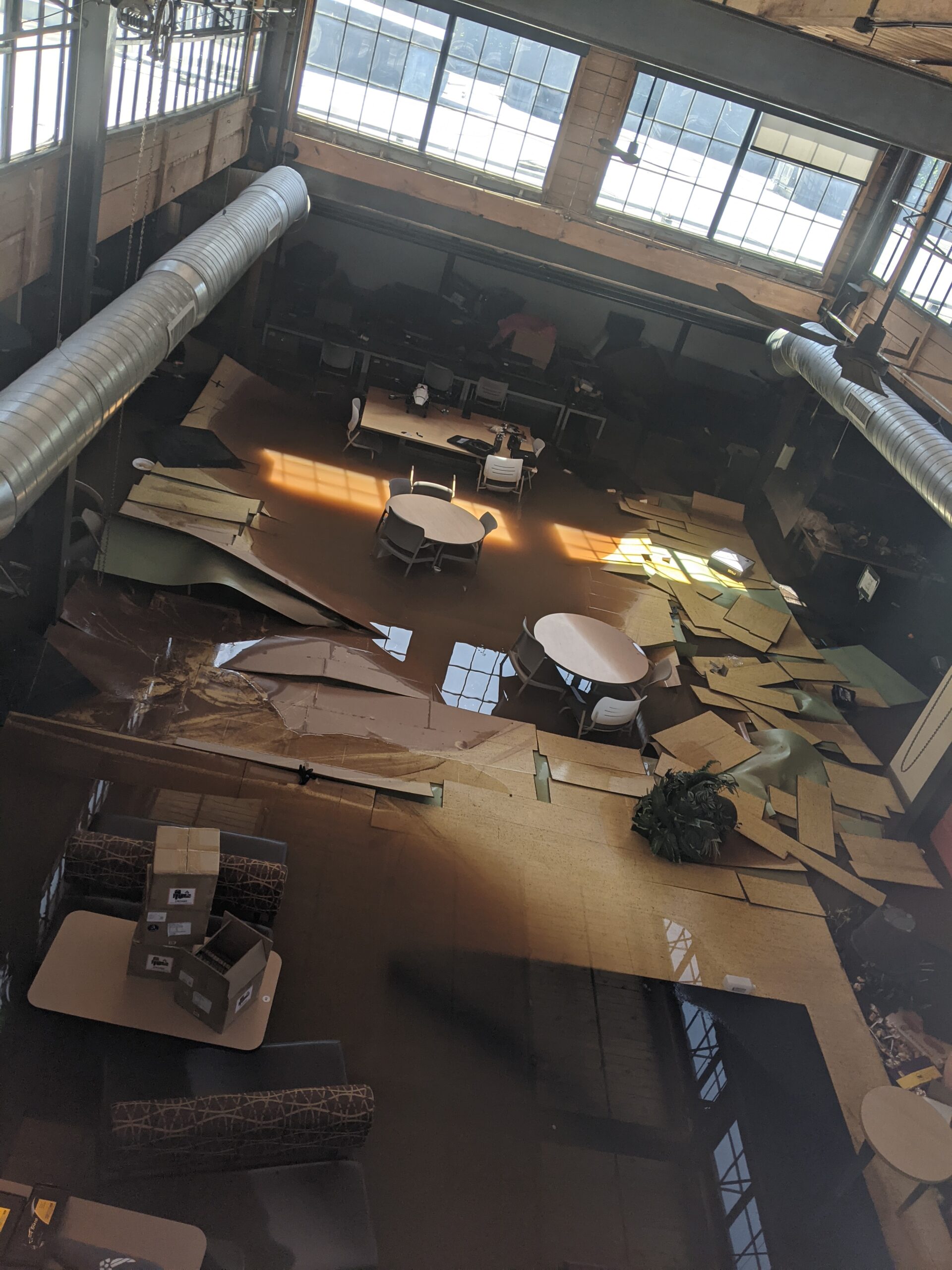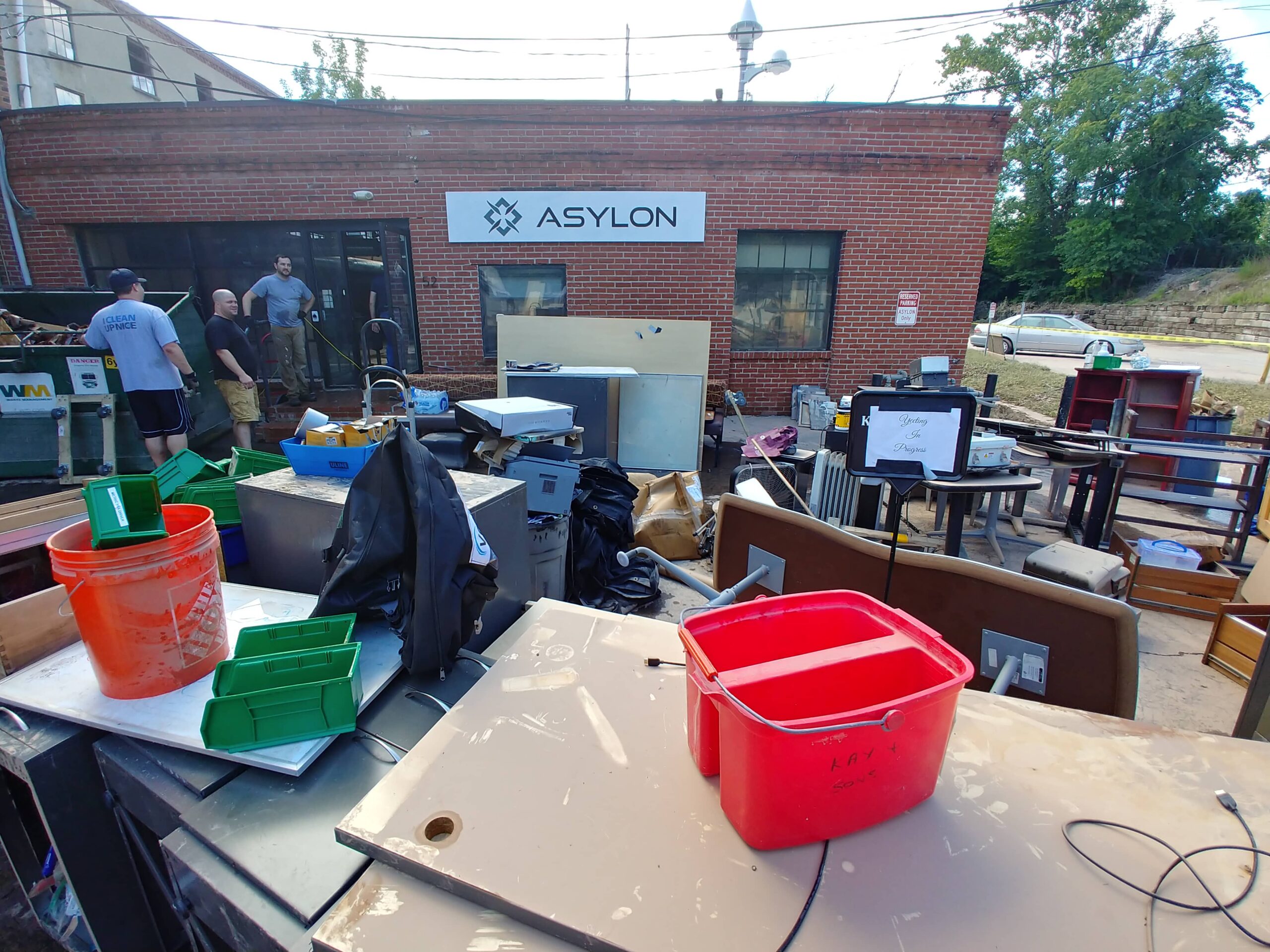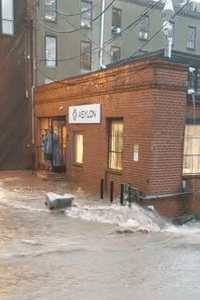
Thirty days ago, Hurricane Ida flooded our headquarters in Norristown, Pennsylvania. The office sits adjacent to the Schuylkill River, which rose to a record 26.85 feet during the storm — nineteen feet higher than normal levels. We watched live from our cloud-based security cameras as water swept through our office, manufacturing line, and Robotic Security Operations Center (RSOC). By the end of the night, our headquarters was filled with over four feet of water.
Fortunately, all of our teammates and their families are safe. However, once the water had receded, estimates indicated well over a million dollars in damages to our assets and the property.
Many others, though, have been affected by this tragedy much worse than we were and our thoughts are with them. Louisiana is having major power outages while New York, Pennsylvania, and New Jersey have all declared a state of emergency as the relief effort continues. If you can, consider donating to provide disaster assistance to the impacted areas through the Red Cross, GlobalGiving, or the charity of your choice.
The purpose of this post is to tell the story of how one American-made small business responded to this crisis, although we believe the types of actions we took are simply representative of the character traits of small businesses themselves. Strong. Resilient. Adaptive. Innovative. Small businesses are the lifeblood of our country and embody the best in who we are.
Here’s a quick summary of the step-by-step actions we took as a team to respond to the natural disaster and come out stronger:
- Take one large collective breath
- Come together, account for known-knowns and known-unknowns
- List the overall objectives & prioritize individual tasks
- Execute & track results
- Re-group, list new objectives, & prioritize tasks
- Execute & track results
- Repeat 5-6
As you can see, our strategy to weathering the storm showed a bias toward group communication, individual empowerment, and action. These are strategies that we find extremely valuable as you will see later on.
But before diving too deep into the details of the story, I’d like to briefly mention a few things.
First and foremost, I want to dedicate this post to the Asylon Team. It was James Lane Allen who said, “Adversity does not build character, it reveals it” and, during and after this disaster, I only saw courage, resilience, grit, and positivity from each member of the team.
Second, a little bit of context about our company is likely helpful for reading on. We’re a full-service Robotic Perimeter Security company that deploys advanced drones and ground robotics systems for automated security. Because automation is our focus, we’re operating and monitoring those systems remotely from our 24/7 Robotic Security Operations Center (RSOC).
Third, we decided as a company to wait to post anything on social media about this incident for thirty days. We did this because we wanted to focus on our next steps and the actions we will take to best support our customers and continue forward. This also allowed us the fortune of being able to track the key results gained from these actions.
Outside of those three quick notes, I’m honored to transcribe the key actions Asylon took in response to this disaster, share various perspectives from the team, and capture the key results of this 30-day all-company push.
Day 0: “The Storm Begins,” September 1, 2021
This day started off as a typical day in the office. It wasn’t until the evening when it became evident that the tropical storm was to be more intense than what we usually see. We took this as an opportunity to test a few new capabilities and were outside flying one of our drones during the heavy rainfall. But, because of the uncertainty of the storm, our COO and co-founder, Brent McLaughlin, elected to stay the night to monitor the situation at the office.
Additionally, we made the decision to transition our remote operations capabilities out of the office. One of the benefits of developing internet of things (IoT) drones and robotics is that we’re not just able to operate these systems anywhere in the world…but it can be done from anywhere in the world.

“The luxury of having such a robust SaaS, IoT, and automated platform is that we were able to quickly enable all levels of staff the ability to execute operations from anywhere with a network connection. The architecture we applied early on allowed us to remain successful from an operational standpoint before, during, and after the flood with minimal overall impact.”
Logan Selby, Vice President of Operations
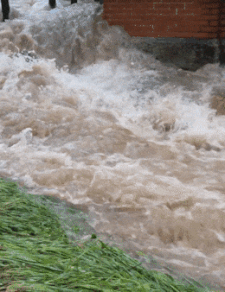
As the night went on and the water in the river rose steadily, Brent made the decision to call a few local teammates to help him prepare the office for a potential flood. Computers, drones, cameras, robots, maintenance equipment, and more were piled onto tables and cabinets as fast as possible.
Around one o’clock in the morning while the crew was still there, the water began to creep into the office as predicted. According to Brent, “You’d be surprised how fast water can start to fill an office! It was a situation that escalated extremely fast and one that required immediate action to protect equipment and stay safe.”
Because water and electricity are never a good combination, the situation quickly became dangerous and the crew left immediately. There was nothing that could be done at this point as the safety of the team was top priority. As the river continued to rise through the night, the office was at the mercy of Mother Nature.
| Key Actions | Key Results |
| Establish a team member to monitor the situation on-site and have a rapid response team ready | Our most valuable equipment was placed high-up and (hopefully) out of reach of any flood water to try to minimize loss |
| Transition 24/7 remote drone flight operations away from our office | Customer drone flights and remote security monitoring continued uninterrupted throughout the night |
Day 1: “What Now?”, September 2, 2021
Early the next morning, Brent and a few others arrived on-scene. The water in the office had receded slightly from its maximum height of over four feet deep but outside it was still high enough to almost completely submerge a car that had been left in the parking lot overnight. Despite the efforts of the late-night crew, the water rose higher than expected and almost all of the equipment inside the office was submerged in the flood water. In the first photo, the red arrow points to a car that is still nearly submerged!
Per Asylon’s pre-established Safety Management System (SMS), emergency response plans and the Emergency Response Team were activated. An all-hands-on-deck meeting was called where our leadership team provided as much detail as possible about the event, answered questions, and stated the current priorities.
After the call, we notified all of our customers about the situation and described the known-knowns and the known-unknowns. At this point, we still couldn’t safely access our office because the water had not fully receded and the extent of the physical damage was still a known-unknown. Our biggest unanswerable concern at this time was the potential damage done, if any, to the extra drones and spares kits used for customer support. As our customers rely on drone operations for safety and security, we always keep a number of spare units ready to be sent to the field on a moment’s notice and those units were now at risk.
Fortunately, because of our foresight the night before and our ability to remotely operate drones and robots via the cloud, our customers continued to see zero impact to their operations, a key priority of ours.
| Key Actions | Key Results |
| Notify customers of known-knowns and known-unknowns | Customers who are informed and partnered to resolve the issue |
| Continue to prioritize remote operations | Dozens of customer missions were remotely launched and monitored during the first 12 hours of this incident |
Days 2-4: “Getting Dirty,” September 3-5, 2021
The office was safe to enter on Friday, September 3rd. On this day and all through that weekend, our team and friendly neighboring companies offered assistance and worked incredibly hard to begin the recovery effort.
All items had to be moved from the office, flooring had to be ripped out, dry wall removed to prevent molding, and had to begin the process of beginning to inventory and account for everything that was lost, damaged, or (hopefully!) in working condition.
However, it became apparent that the extent of the storm damage was greater than expected. The situation quickly transitioned from ‘What’s broken?’ to ‘What isn’t broken?’
As a start-up, we employees have put our heart and soul into the development of this company. It was a difficult and emotional experience to see all the damage that had been done. However, the sense of unity as well as the constant positive encouragement coming from all directions reminded us that we are here as a team, and as a team we will persevere. It’s rare to have the opportunity to not just witness that sort of unity, but to be a part of it.
“It’s the Asylon Effect. We came together as a family to support each other and the company as a whole, that’s just what we do. At this point we only have one direction we can move and that direction is forward. We’ve got work to do.”
Dustin Kammler, Maintenance Lead
The work accomplished during these days set the stage for next-steps. As drones and spares kits were damaged in the flood, it was apparent we needed to replenish them as soon as possible. Thankfully, some equipment was saved in waterproof Pelican cases so we had some available units to send to customers in case of any service-related issue at a site. If interested, Pelican is creating a Survival Story on us so sign up for our newsletter to be the first to see it.
Because of the spares saved by the Pelican cases and our ability to use our software to remotely operate all of our systems, our momentum started to build as a team and we fed off of that energy.
| Key Action | Key Results |
| Work through the weekend to triage and catalogue the wreckage | Multiple thousands of items catalogued, photographed, tested, and sorted Developed a baseline inventory gap analysis |
Days 5-14: “All-Hands, All-Action”, September 6-15, 2021
Going into the week following the hurricane, there were about half a dozen different initiatives taking place. All-company meetings were held and helped to ensure we were all on the same page. Team leads had specific objectives and daily tag-ups on company-wide initiatives. There were all kinds of gears turning and systems being built back into place from a diverse group of perspectives, skill sets, and capabilities.
What we found from our relief work over the weekend was that we were fortunate enough that a few drones and spares kits were untouched. Having a healthy supply of these systems is paramount to customer success so maintenance and manufacturing were placed high on our priority list to increase that supply further. Because we had a much deeper level of understanding of the situation after the initial triage efforts, the team was now able to start to divide and conquer responsibilities, paving a path for restarting critical processes.
Outside of the continuing physical recovery efforts, countless phone calls and email exchanges took place to move the business forward. Partners, investors, advisors, and government officials were contacted to collaborate and discuss the various options available to work through the disaster. We’ve received unbelievably resounding support from everyone and we want to give a special thanks to those individuals and groups.
One to mention in particular is our landlord, Bill Corbett, who, while committing to a complete 45-day remodel of our entire office, has been letting our team work out of the Corbett, Inc. Experience Center. As a result, not only are we building our office back significantly better than before but all departments retain the ability to work in-person as a team together.
“I can’t tell you how many positive conversations I had in those first two weeks. Though we all had an initial direction on recovery, starting the process seemed like a monumental effort. I found that each internal and external conversation helped put a different piece of the puzzle together and we were finally able to start to move the tides in our favor.”
Damon Henry, CEO & Co-Founder
| Key Actions | Key Results |
| Purchase equipment and parts identified in the inventory gap analysis Set up a temporary manufacturing operation |
A replenished critical spares kit inventory |
| Contact partners, investors, advisors, and government officials | Identified multiple paths available for disaster relief financing and company growth |
Days 15-30: “Building Better”, Sept. 16 – Oct. 1, 2021
After the dust settled and with the initial disaster recovery response complete, spares kits replenished, and a complete picture of the situation identified, there was a brief moment of calm. Our team was able to take another collective breath and reset.
Going forward, the question was asked… “How can we, instead of merely responding to this crisis, turn it into a net positive change for the company as a whole?”
The flooding was a major disaster, yes. But it provided us with the opportunity to ask that specific question.
As a result, there are plenty of new and exciting developments coming down the pike. I’m excited to share those with you as they take place.
To track that journey, be sure to follow us on LinkedIn or sign up for our newsletter.
As we continue to take action and move forward, there are a few key takeaways we’ve gathered from this whole event:
- We believe we’ve faced one of the most difficult challenges our company will ever experience and we’re proud that our customers remained completely unaffected during this time — proving ourselves capable of tackling future challenges.
- We have proof through our actions that we have our customers’ and teams’ backs if disaster does strike again. The tremendous results gained during this recovery effort were made possible by our incredible customers, partners, and team.
Our actions don’t stop here; we’re not finished. This was only the Last 30 Days. Like all the other small businesses out there who are fighting and working diligently to overcome this disaster, we’re resilient, strong, innovative, adaptive, and looking forward to what’s next.
If you have a similar story, we’d love to hear from you. Just email Info@AsylonRobotics.com any time to get in touch.
